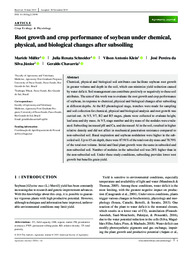Root growth and crop performance of soybean under chemical, physical, and biological changes after subsoiling.
Root growth and crop performance of soybean under chemical, physical, and biological changes after subsoiling.
Author(s): MÜLLER, M.; SCHNEIDER, J. R.; KLEIN, V. A.; SILVA JUNIOR, J. P. da; CHAVARRIA, G.
Summary: Chemical, physical and biological soil attributes can facilitate soybean root growth in greater volume and depth in the soil, which can minimize yield reduction caused by water deficit. Soil management can contribute positively or negatively to these soil attributes. The aim of this work was to evaluate the root growth and crop performance of soybean, in response to chemical, physical and biological changes after subsoiling at different depths. At the R5 phenological stage, trenches were made for sampling and soil collection for chemical, physical and biological analysis and root growth was carried out. At V5, V7, R2 and R5 stages, plants were collected to evaluate height, leaf area and dry mass. At V5, stage number and dry mass of the nodules were evaluated. Subsoiling increased pH and Ca, and decreased Al in the soil, resulted in higher relative density and did not affect in mechanical penetration resistance compared to non-subsoiled soil. Basal respiration and soybean nodulation were higher in the subsoiled soil. Up to 15 cm depth, there were 87.91% of the total root dry mass and 78.79% of the total root volume. Initial and final plant growth were the same in subsoiled and non-subsoiled soil. Number of nodules in the subsoiled soil was 28% higher than in the non-subsoiled soil. Under these study conditions, subsoiling provides lower root growth but benefits grain yield.
Publication year: 2020
Types of publication: Journal article
Unit: Embrapa Wheat
Keywords: Root growth, Soil, Soybeans
Observation
Some of Embrapa's publications are published as ePub files. To read them, use or download one of the following free software options to your computer or mobile device. Android: Google Play Books; IOS: iBooks; Windows and Linux: Calibre.
Access other publications
Access the Agricultural Research Database (BDPA) to consult Embrapa's full library collection and records.
Visit Embrapa Bookstore to purchase books and other publications sold by Embrapa.

